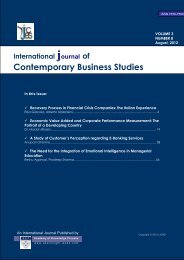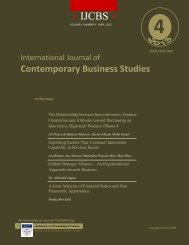International journal of Contemporary Business Studies
International journal of Contemporary Business Studies
International journal of Contemporary Business Studies
Create successful ePaper yourself
Turn your PDF publications into a flip-book with our unique Google optimized e-Paper software.
<strong>International</strong> Journal <strong>of</strong> <strong>Contemporary</strong> <strong>Business</strong> <strong>Studies</strong><br />
Vol: 3, No: 6. June, 2012 ISSN 2156-7506<br />
Available online at http://www.akpinsight.webs.com<br />
1.5Culture<br />
The final managerial lever is culture. Organizational culture includes shared vision where clearer vision<br />
would act as effective facilitator to innovation (Adams, et al., 2006). In fact, culture brings values and<br />
beliefs, attitudes and experiences which is shared by personnel in organization (Kanchan & Gupta, 2009;<br />
Martins & Terblanche, 2003). In order to influence creativity and innovation, culture is influenced by<br />
several determinants such as strategy, structure, support mechanisms, behavior, and open communication<br />
(Martins & Terblanche, 2003). Culture also reflect a degree to which values, norms and artifacts support<br />
the organization‟s innovativeness (Stock & Zacharias, 2011). Thus, it is noted that organizational culture<br />
will push organizational members towards creating innovation mentality (Stock & Zacharias, 2011).<br />
According to Ahmed (1998), culture has multiple elements which could enhance <strong>of</strong> exhibit tendency to<br />
innovate. He pointed that culture should not be isolated and need to match with organizational context.<br />
Thus, balance and understanding <strong>of</strong> context is important because culture with strong drive towards<br />
innovation could lead to problems when market circumstances and customer requirements demand<br />
predictability and conforming to specifications (Ahmed, 1998).<br />
Implementing innovation in the organization would accommodate risk <strong>of</strong> failure and uncertainty,<br />
Therefore, Kanchan and Gupta (2009) has suggested to change the corporate culture which is important to<br />
have a set <strong>of</strong> understanding that people <strong>of</strong> an organization share in common. In this context, several<br />
criteria have been highlighted to change corporate culture include: committed in becoming innovative<br />
organization through informed decision and investment, consistent communication, physical and<br />
organizational support, stimulating environment, encouragement for innovation and compensation<br />
(Kanchan & Gupta, 2009). These criteria shared similar arguments by previous scholar, Madan (2000),<br />
which added the importance <strong>of</strong> the leadership role <strong>of</strong> top management values, attitudes and leadership<br />
style. There is also other approach to indicate that culture is an operating mechanism to support<br />
innovation. For instance, „culture field concept‟ is proposed to promote innovation through climate style<br />
management entity (Qingrui, Ling, & Zhangshu, 2003). In this approach, firm need to cultivate employee<br />
individual innovative ability so that their firm will form core competencies in all elements <strong>of</strong> innovation<br />
(Qingrui, et al., 2003).<br />
An empirical findings on innovation in SMEs has proven that general organization culture and specific<br />
organization culture with regards to innovation projected good impact on innovation levels (Kenny &<br />
Reedy, 2006). General organization culture is the familiarity <strong>of</strong> mission statement and R&D aspects <strong>of</strong> the<br />
company while specific culture <strong>of</strong> innovation were the innovation strategy, type <strong>of</strong> innovation engaged,<br />
drivers and constrains <strong>of</strong> innovation (Kenny & Reedy, 2006). It is noted most authors have stress on the<br />
importance <strong>of</strong> innovative culture due to the innovation activities as a method <strong>of</strong> competitive<br />
differentiation and ways <strong>of</strong> customer value creation. For that matter, Dobni (2008) has empirically<br />
presented innovation culture constructs based on seven factors: innovation propensity, organizational<br />
constituency, creativity and empowerment, market orientation, value orientation and implementation<br />
context.<br />
In a study <strong>of</strong> product innovation, it is found that companies should foster cultures with external and<br />
flexibility orientation and culture is also act as determinant to innovation strategy (Julia C. Naranjo<br />
Valencia, Valle, & Jimenez, 2010). Thus, hocratic cultures (emphasizes flexibility and change) could<br />
enhance the development <strong>of</strong> new products or service while hierarchical cultures inhibit product<br />
innovation (Julia C. Naranjo Valencia, et al., 2010). Organization that implemented both radical and<br />
incremental innovation is found to have culture that cultivate learning and knowledge sharing contributed<br />
significant relationship into innovation (Lin & Edward F. McDonough III, 2011). Besides, innovation<br />
culture which is promoted in the organization would depended on the right types norms which is widely<br />
shared and activate creativity (Ahmed, 1998). These norms include challenge and belief in action,<br />
freedom and risk taking, dynamism and future orientation, external orientation, trust and openness,<br />
Copyright © 2012. Academy <strong>of</strong> Knowledge Process<br />
11
















